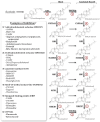Chemical Inhibition of Sterol Biosynthesis
- PMID: 38672427
- PMCID: PMC11048061
- DOI: 10.3390/biom14040410
Chemical Inhibition of Sterol Biosynthesis
Abstract
Cholesterol is an essential molecule of life, and its synthesis can be inhibited by both genetic and nongenetic mechanisms. Hundreds of chemicals that we are exposed to in our daily lives can alter sterol biosynthesis. These also encompass various classes of FDA-approved medications, including (but not limited to) commonly used antipsychotic, antidepressant, antifungal, and cardiovascular medications. These medications can interfere with various enzymes of the post-lanosterol biosynthetic pathway, giving rise to complex biochemical changes throughout the body. The consequences of these short- and long-term homeostatic disruptions are mostly unknown. We performed a comprehensive review of the literature and built a catalogue of chemical agents capable of inhibiting post-lanosterol biosynthesis. This process identified significant gaps in existing knowledge, which fall into two main areas: mechanisms by which sterol biosynthesis is altered and consequences that arise from the inhibitions of the different steps in the sterol biosynthesis pathway. The outcome of our review also reinforced that sterol inhibition is an often-overlooked mechanism that can result in adverse consequences and that there is a need to develop new safety guidelines for the use of (novel and already approved) medications with sterol biosynthesis inhibiting side effects, especially during pregnancy.
Keywords: DHCR24; DHCR7; cholesterol; pharmaceutical inhibition of cholesterol synthesis.
Conflict of interest statement
The authors declare no conflicts of interest. The funders had no role in the design of the study; in the collection, analyses, or interpretation of data; in the writing of the manuscript; or in the decision to publish the results.
Figures


References
Publication types
MeSH terms
Substances
Grants and funding
LinkOut - more resources
Full Text Sources
Miscellaneous

